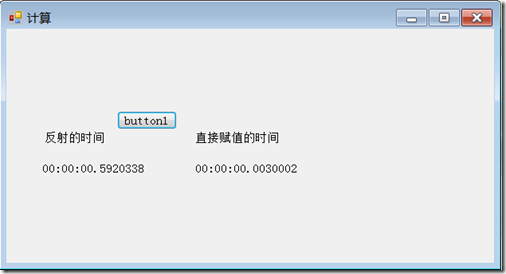一直听别人说 反射慢,但是真正的到底有多慢,你知道吗?反正我不知道。
具体的,我们上一下图。通过100000次计算后两个的值。
为了验证反射。首先来一个类:
简单一点 如下
public class People
{
public string Name { get; set; }
public int Age { get; set; }
public bool Sex { get; set; }
public string ID { get; set; }
public String Country { get; set; }
}
再来一个 反射赋值的方法(这里假设都有一个 无参数的构造方法。)
class AssimblelyHelp
{
/// <summary>
/// 反射将T2的值付给T1
/// </summary>
/// <typeparam name="T"></typeparam>
/// <param name="t1"></param>
/// <param name="t2"></param>
/// <returns></returns>
public static T GetValue<T>(T t1, T t2) where T : new()
{
Type type = typeof(T);
//获取默认的类型
T temp = new T();
PropertyInfo[] propertys = type.GetProperties();
foreach (var property in propertys)
{
if (property != null && property.GetValue(temp) != property.GetValue(t2))
{
if (property.GetValue(t2)!=null)
{
property.SetValue(t1, property.GetValue(t2));
}
}
}
return t1;
}
}
然后就是写的一个小小的 测试程序
public partial class Form1 : Form
{
public Form1()
{
InitializeComponent();
}
private void button1_Click(object sender, EventArgs e)
{
People people2 = new People() {Country = "china",ID = "222",Name = "小美人",Sex = false};
People people1= new People(){Age=20};
DateTime time0= DateTime.Now;
for (int i =0; i < 100000; i++)
{
//Type type = typeof(People);
// var [] propertys = people2.GetType().GetProperties();
AssimblelyHelp.GetValue(people1, people2);
}
DateTime time1= DateTime.Now;
label1.Text = (time1 - time0).ToString();
DateTime time2 = DateTime.Now;
for (int i = 0; i < 100000; i++)
{
SetValue(people1); ;
}
DateTime time3 = DateTime.Now;
label2.Text = (time3 - time2).ToString();
}
private static People SetValue(People people11)
{
// People people11 = new People();
people11.Age = 18;
people11.Country = "china";
people11.ID = "222";
people11.Name = "小美人";
people11.Sex = false;
return people11;
}
}
结论:反射的结果大约是19.66666666666667倍的时间。这还不算部分没有出现的属性。因为反射一样要花时间的。
